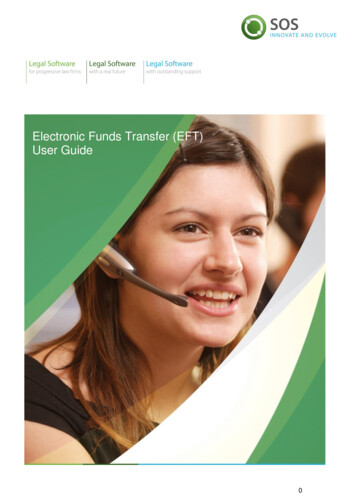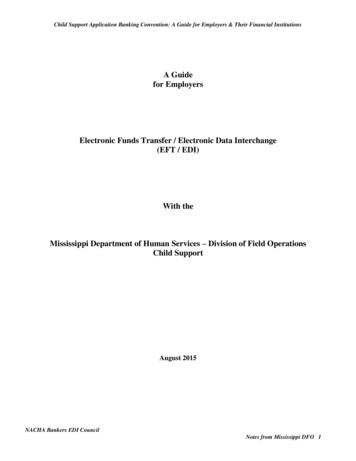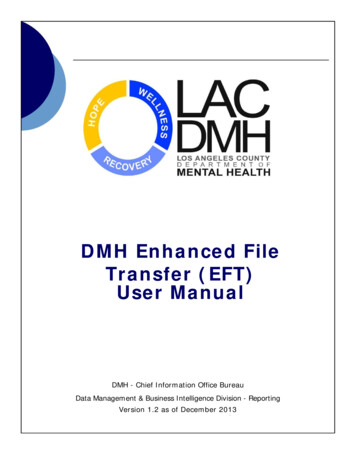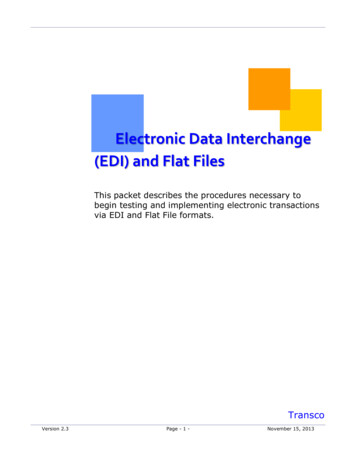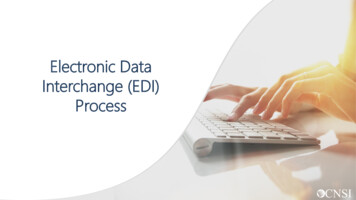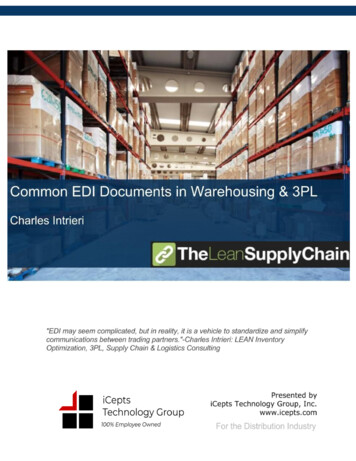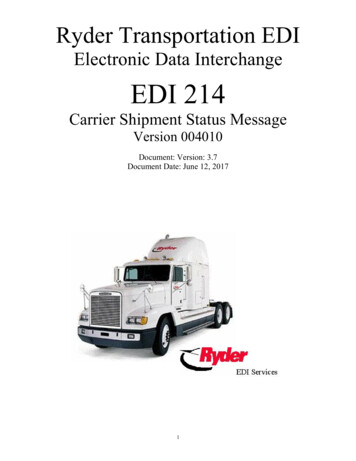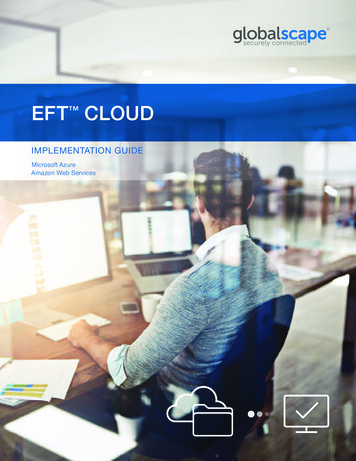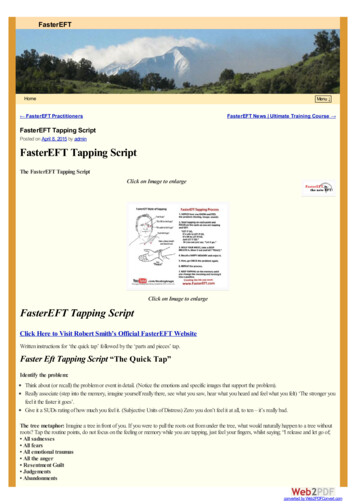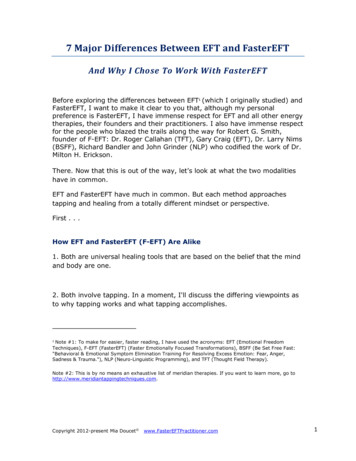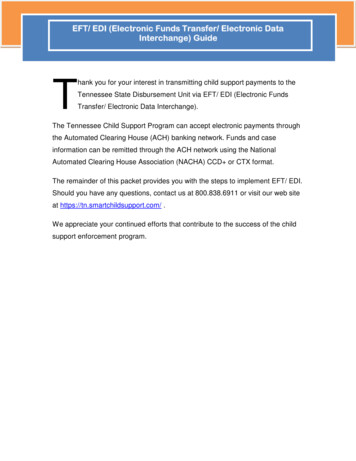
Transcription
EFT/ EDI (Electronic Funds Transfer/ Electronic DataInterchange) GuideThank you for your interest in transmitting child support payments to theTennessee State Disbursement Unit via EFT/ EDI (Electronic FundsTransfer/ Electronic Data Interchange).The Tennessee Child Support Program can accept electronic payments throughthe Automated Clearing House (ACH) banking network. Funds and caseinformation can be remitted through the ACH network using the NationalAutomated Clearing House Association (NACHA) CCD or CTX format.The remainder of this packet provides you with the steps to implement EFT/ EDI.Should you have any questions, contact us at 800.838.6911 or visit our web siteat https://tn.smartchildsupport.com/ .We appreciate your continued efforts that contribute to the success of the childsupport enforcement program.
EFT/ EDI (Electronic Funds Transfer/ Electronic DataInterchange) GuideEFT/ EDI OverviewWhat is EFT/ EDI?EFT/ EDI is the process of sending (child support) payments electronically through the ACH(Automated Clearing House) banking network, which is a government facility that coordinatesthese types of transactions.EFT (electronic funds transfer) refers to the sending of money electronically, while EDI(electronic data interchange) refers to sending (electronically) the case information that isrequired in order to post the payment and credit the non-custodial parent.How does EFT/ EDI work?1. Your company electronically transmits the payment and remittance information to yourfinancial institution.2. Your financial institution originates the ACH entries required to transfer child supportwithholdings via the ACH network to the financial institution that the State Disbursement Unit(SDU) uses to collect the funds.3. The SDU electronically collects your payments and remittance information for processing.How does my company benefit from EFT/ EDI?EFT/ EDI provides your company with long-term financial savings in operating costs by: Increasing accuracy Increasing reliability—no lost checks or mail delays Reducing paperwork Eliminating postage costs Reducing the possibility of theft or fraud7/20171
EFT/ EDI (Electronic Funds Transfer/ Electronic DataInterchange) GuideImplementing EFT/ EDIThere are four steps to implementing EFT/ EDI for child support withholdings:1.Submit identifying employee information (name, child support case number, social securitynumber) to the SDU for reconciliation.2.Adapt your payroll system to create the ACH file.3.Coordinate with your financial institution to set up the file transfer process.4.Test the process with your financial institution and the SDU.1. Submit identifying information to the SDU for reconciliation.It is important that the identifying information you submit with your child support withholdingsmatch the identifying information in the State of Tennessee’s child support computer system. Ifthe information does not match, there may be a delay in processing child support payments.To ensure families receive support payments in a timely manner, identifying information mustbe reconciled against the State’s child support computer system prior to transmitting childsupport withholdings via EFT/ EDI. This process can be accomplished by registering athttps://tn.smartchildsupport.com and selecting EFT/ EDI as your payment method. The site willthen take you step by step through the reconciliation process. If you need further assistance,you may contact us at 800.838.6911 and ask to speak with our Employer Outreach Coordinator.2. Adapt your payroll system to create the ACH file.To implement EFT/ EDI, your payroll system or other computer system must be able to createthe data structure to build the ACH file that you will transfer to your financial institution. TheUser Guide for Electronic Child Support Payments: Using the Child Support Application BankingConvention prescribes the appropriate formats and standards for transmitting EFT/ EDI childsupport withholdings. You can download this publication at https://tn.smartchildsupport.com byclicking the link (on the left side of the page) NACHA’s User Guide for Electronic Child SupportPayments. The materials in this packet have been adapted from this guide.There are software applications that accommodate the required data (your existing payrollsystem may already offer this function). You can also contact your financial institution regardingavailable ACH software.3. Coordinate with your financial institution.Contact your financial institution to determine its capabilities and requirements. In most cases,an institution is already accustomed to receiving and sending EFT/ EDI transmissions. You mayneed to complete an agreement with your financial institution that authorizes you to transferEFT/ EDI child support withholdings to the SDU.7/20172
EFT/ EDI (Electronic Funds Transfer/ Electronic DataInterchange) GuideImplementing EFT/ EDI4. Test the process with your financial institution and the TN SDU.Conduct a test transmissionAfter you complete any necessary changes to your computer system, you must conduct a testtransmission of child support withholding information with your financial institution. Based on theresults of this test, some additional changes may be necessary to your computer system or thefinancial institution’s computer system. You should continue to test the process until both youand the financial institution are satisfied that the information is being transferred completely andaccurately.Conduct a prenotification (prenote)After perfecting the transmission of child support withholding information between you and yourfinancial institution, contact the SDU at 800.838.6911 to arrange a prenote prior to your firstactual transmission. A prenote simulates a future live transmission and is used to ensure thebanking information included with the transmission is correct. The prenote contains zeros in theamount field to make certain that no funds are transferred during this test.7/20173
EFT/ EDI (Electronic Funds Transfer/ Electronic DataInterchange) GuideEFT/ EDI Record FormatsThe following record formats are used to convey entries through the ACH network: File Header Record—Record 1 Company/ Batch Header Record—Record 5 Entry Detail Record—Record 6 Addenda Record—Record 7 Company/ Batch Control Record—Record 8 File Control Record—Record 9An ACH file begins with a file header record (1) and ends with a file control record (9) whichserves to facilitate transmission, identification, and balancing of the file.The file may contain one or more unique batches each starting with a company/ batch headerrecord (5) and ending with a company/ batch control record (8). These records containinformation specific to all of the entry detail records within that batch. Your company can sendmultiple batches in the same file. This gives you the opportunity to group your transactions invarious ways; for example, by division, location, payroll frequency.The ACH file also consists of the entry detail record (6) and the addenda record (7). Theentry detail record contains the information necessary to transfer the funds from your financialinstitution to the SDU’s financial institution. The addenda record is used to supply informationabout your employee and how to apply the child support payment. Each addenda recordincludes an 80-position payment-related information field within which this remittance detail istransmitted.There are two types of payment formats available for use: CCD or CTX. You will need tocheck with your financial institution to see if it supports these format types.The remainder of this packet contains the following: Entry Flow CCD Entry Detail Record Layout—Record 6 CTX Entry Detail Record Layout—Record 6 Addenda Record Layout—Record 7 CCD DED Child Support Segment/ Convention for Employers DED Data Element Definitions7/20174
EFT/ EDI (Electronic Funds Transfer/ Electronic DataInterchange) GuideEntry FlowThe record formats for CCD entries flow in the following order:File Header RecordCompany/ Batch Header RecordEntry Detail RecordAddenda Record (1 addenda with 80 byte payment related information field)Entry Detail RecordAddenda Record (1 addenda with 80 byte payment related information field)Entry Detail RecordAddenda Record (1 addenda with 80 byte payment related information field)Company/ Batch Control RecordFile Control RecordThe record formats for CTX entries flow in the following order:File Header RecordCompany/ Batch Header RecordEntry Detail RecordAddenda Record (up to 9,999 addenda with 80 byte payment related information field)Addenda RecordAddenda RecordEntry Detail RecordAddenda Record (up to 9,999 addenda with 80 byte payment related information field)Addenda RecordAddenda RecordCompany/ Batch Control RecordFile Control RecordNOTE: The CTX must contain a fully formatted ASC 820 transaction set, which includes allenvelopes, table 1, and table 2, which can contain multiple DED loops. The syntacticallycorrect ASC 820 is then broken into 80 byte segments embedded in the CTX 07addenda records.7/20175
EFT/ EDI (Electronic Funds Transfer/ Electronic DataInterchange) GuideCCD Entry Detail Record Layout—Record 6Field ngthPositio Descriptionn1Record TypeM6101-01Constant FIIdentificationMTTTTAAAA804-11SDU will provideafter data isreconciled4Check DigitMNumeric112-12SDU will provideafter data isreconciled5DFI AccountNumberRAlphanumeric1713-29SDU will provideafter data isreconciled6AmountM cc1030-39999999v99Credits meric179-791 (there must beone addendarecord for eachentry detail record)11TraceNumberMNumeric1580-94Assigned by theoriginating bankTN Child SupportField Inclusion RequirementM: mandatory for the ACH network.R: required for this application.O: optional for the ACH network, but may be required by the child support agency.7/20176
EFT/ EDI (Electronic Funds Transfer/ Electronic DataInterchange) GuideCTX Entry Detail Record Layout—Record 6Fie Data thPositionDescription1Record TypeM6101-01Constant “6”2TransactionCodeMNumeric202-03223Receiving DFIIdentificationMTTTTAAAA804-11SDU will provide after datais reconciled4Check DigitMNumeric112-12SDU will provide after datais reconciled5DFI AccountNumberRAlphanumeric1713-29TN CCU will provide afterdata is reconciled6Total AmountM cc1030-39999999v99Credits er ofAddendaRecordsMNumeric455-58Number of addendarecords included inpayment9ReceivingCompany NameRAlphanumeric1659-74TN Child Support10ReservedBlank275-76Leave this field daRecord IndicatorMNumeric179-791 (there may be up to9,999 addenda records foreach entry detail record)13Trace NumberMNumeric1580-94Assigned by the originatingbankN/AField Inclusion RequirementM: mandatory for the ACH network.R: required for this application.O: optional for the ACH network, but may be required by the child support agency.7/20177
EFT/ EDI (Electronic Funds Transfer/ Electronic DataInterchange) GuideAddenda Record Layout—Record 7Field ngthPosition Description1Record TypeCodeM7101-0172AddendaType eric8004-83See CCD DEDChild SupportSegment/Convention forEmployers 01 for CCD Entry DetailSequenceNumberM5Ascending orderfor CTXNumeric788-94Matches itemnumber part of“trace” numberField 3: Payment Related InformationThis field contains the remittance information for each payment. The layout for this field is onthe next page; CCD DED Child Support Segment/ Convention for Employers.Field Inclusion RequirementM: mandatory for the ACH network.R: required for this application.7/20178
EFT/ EDI (Electronic Funds Transfer/ Electronic DataInterchange) GuideCCD DED Child Support Segment/ Convention for EmployersDataElementCommentsContentsSegment IdentifierDEDAttributes123MID3/3DED01Application IdentifierCSMID2/2DED02Case IdentifierXXXXXXXXXX (employee’scase number)MAN1/20DED03Pay DateYYMMDD (date ofwithholding)MDT6/6DED04Payment Amount ccMN21/10DED05Non-custodial Parent SSNXXXXXXXXX (employee’sSSN)MAN9/9DED06Medical Support IndicatorY Yes; N NoMAN1/1DED07Non-custodial 7DED09Employment TerminationIndicatorY YesRAN1/1Each data element (DED0X) occupies a specific position within the record segment and isidentified by a unique identifier. In constructing the record segment, each data element ispreceded by the separator character. The ACH network requires that an asterisk (*) be used asthe data element separator. Each segment must end with a terminator, which in the ACHnetwork is a backslash (\).The following is an example of the Deduction (DED) data segment as used in the paymentrelated information segment of the addenda record:DED*application identifier*case identifier*pay date*payment amount*non-custodial parentssn*medical support indicator*non-custodial parent name*FIPS code*employmenttermination indicator\.Note the use of the “*” and “\”.7/20179
EFT/ EDI (Electronic Funds Transfer/ Electronic DataInterchange) GuideDED Data Element DefinitionsDED01 Application Identifier—the type of deduction being withheld from the employee’swages. The value for this field is always “CS” (child support). Mandatory fieldDED02 Case Identifier—the employee’s child support case number. Mandatory fieldDED03 Pay Date—the date that your company will deduct the child support from theemployee’s wages. This date must be equal or prior to the date that the EFT/ EDI transactionreaches the SDU. The date is expressed in the format: year, month, and day. Mandatory fieldDED04 Payment Amount—the amount that your company will withhold from an employee’swages in compliance with an income withholding order or notice. The decimal point is implied tobe the last two positions of the number shown. Do not include a decimal point in this field. Thisfield cannot be zero unless the Employment Termination Indicator in DED09 is set to “Y.”Mandatory fieldDED05 Non-Custodial Parent SSN—the social security number of the employee for whom youare withholding child support. This field should be the same number that you entered in DED02.Mandatory fieldDED06 Medical Support Indicator—identifies whether your company offers family medicalcoverage to the employee. Place a “Y” in this field if family medical insurance is available; ifthere is no coverage available, place an “N” in this field. Please note the question is, “Does yourcompany offer family medical coverage for this employee?” not “Does the employee havefamily medical coverage?” Mandatory fieldDED07 Non-Custodial Parent Name—the first seven (7) letters of the employee’s last name,followed by the first three (3) letters of his or her first name. A comma must be used to separatethe last name of the employee when the last name is less than seven (7) characters. Do notenter more than ten (10) positions even if you do not have enough room for the full name. Inmost cases you will not be able to fit the full name in this field. Mandatory fieldDED08 FIPS Code—federal information process standard (FIPS) code. This field shouldalways contain “4700001.” Mandatory fieldDED09 Employment Termination Indicator—notifies the child support agency that anindividual’s employment has terminated. Place a “Y” in this field if the individual is no longeremployed at your company, or if this is the last pay period that the individual will be employed atyour company. This is a required field if the employee is no longer employed at your company.The only time that the Payment Amount (DED04) can be zero is when this field is set to “Y.” “Y”is the only value that has any meaning in this field.NOTE: Please do not place a “Y” in this field when an employee is on temporary leave. If anemployee is on temporary leave, it is not necessary to submit a record 6 and 7 for thatindividual until they return to work and you begin withholding once again.7/201710
EFT/ EDI (Electronic Funds Transfer/ Electronic Data Interchange) Guide Implementing EFT/ EDI There are four steps to implementing EFT/ EDI for child support withholdings: 1. Submit identifying employee information (name, child support case number,
